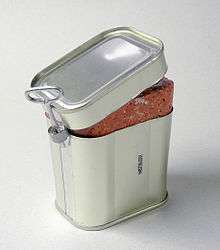Bully beef
Bully beef (also known as corned beef in the United Kingdom, Ireland and Canada) refers to a variety of meat made from finely minced corned beef in a small amount of gelatin. The name "bully beef" comes from the French "bouilli" (boiled) in Napoleonic times, or possibly from the head of a bull depicted on the popular Hereford brand of canned corned beef. The cans have a distinctive oblong shape. Bully beef and hardtack biscuits were the main field rations of the British Army from the Boer War to World War II.[1][2] It is commonly served sliced in a corned beef sandwich. Potato-based dishes, such as "Hash and hotch-potch", in which the potatoes and beef are stewed together, and "Corned Beef Hash", where pre-boiled potatoes and corned beef are mixed with Worcestershire sauce then fried, are also made. Tinned corned beef is also used in mainland Europe.[3] Some places where British troops had a heavy presence in the 20th century (especially during World War II), such as Malta, have adopted bully beef as part of their national cuisine. In February 2009, the British Defence Equipment and Support announced that they would be phasing out bully beef from ration packs as part of the introduction of the new Multi-Climate Ration Packs.[4]

See also
- Potted meat

References
-
"Bully beef: Part of Australian history". Taste.com.au. Taste Magazine. Retrieved 24 July 2017.
A hundred years ago our soldiers at Gallipoli knew it as bully beef. It came in cans.
- "Exhibitions : Changing the World : Fascinating Facts – Page 2". National Army Museum. Archived from the original on 1 October 2006. Retrieved 10 October 2018.
- "Recettes à base de corned beef – Les recettes les mieux notées". 750g.com. Retrieved August 29, 2010.
- Harding, Thomas (5 Feb 2009). "Army says goodbye to bully beef". The Telegraph. U.K. Retrieved 24 July 2017.